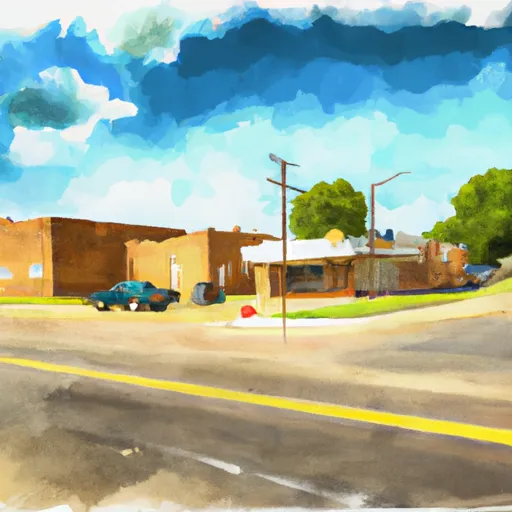-
 Snoflo Premium
Snoflo Premium
Get unlimited access to all our content
With no Ad interruptions! - Start Your Free Trial Login with existing account
Meeker
Eden Index
Climate
8.3
•
Recreation
3.4
•
Community
2.2
•
Safeguard
5.0/10

Meeker, Oklahoma is a small town located in Lincoln County. The climate in Meeker is considered humid subtropical, characterized by hot summers and mild winters. Summer temperatures often reach the upper 90s°F, while winter temperatures average in the mid-40s°F. Precipitation is fairly evenly distributed throughout the year, with an annual average of around 40 inches. The area experiences occasional severe weather such as thunderstorms and tornadoes.
Meeker is situated near several bodies of water, including the North Canadian River and Deep Fork River. These rivers, along with nearby lakes such as Prague Lake and Lake Thunderbird, provide hydrology constituents for the town. The rivers and lakes offer opportunities for various water activities such as fishing, boating, and swimming.
Outdoor recreation enthusiasts in Meeker can enjoy activities such as hiking, camping, and picnicking in the nearby parks and wildlife areas. The Deep Fork National Wildlife Refuge, just a short distance away, provides opportunities for birdwatching and wildlife observation. Additionally, the area is surrounded by scenic landscapes, making it an ideal location for nature photography and peaceful walks.
What is the Eden Index?
The Snoflo Eden Index serves as a comprehensive rating system for regions, evaluating their desirability through a holistic assessment of climate health, outdoor recreation opportunities, and natural disaster risk, acknowledging the profound impact of these factors on livability and well-being.
Climate Health Indicator (CHI): 8.3
Meeker receives approximately
980mm of rain per year,
with humidity levels near 80%
and air temperatures averaging around
16°C.
Meeker has a plant hardyness factor of
7, meaning
plants and agriculture in this region tend to thrive during the non-winter months.
By considering the ideal temperature range, reliable water supplies, clean air, and stable seasonal rain or snowpacks, the Climate Health Indicator (CHI) underscores the significance of a healthy climate as the foundation for quality living.
A healthy climate is paramount for ensuring a high quality of life and livability in a region, fostering both physical well-being and environmental harmony. This can be characterized by ideal temperatures, reliable access to water supplies, clean air, and consistent seasonal rain or snowpacks.
Weather Forecast
Streamflow Conditions
Lower North Canadian
Area Rivers
Lower North Canadian
Snowpack Depths
Lower North Canadian
Reservoir Storage Capacity
Lower North Canadian
Groundwater Levels
Recreational Opportunity Index (ROI): 3.4
The Recreational Opportunity Index (ROI) recognizes the value of outdoor recreational options, such as parks, hiking trails, camping sites, and fishing spots, while acknowledging that climate plays a pivotal role in ensuring the comfort and consistency of these experiences.
Access to outdoor recreational opportunities, encompassing activities such as parks, hiking, camping, and fishing, is crucial for overall well-being, and the climate plays a pivotal role in enabling and enhancing these experiences, ensuring that individuals can engage in nature-based activities comfortably and consistently.
Camping Areas
| Campground | Campsites | Reservations | Toilets | Showers | Elevation |
|---|---|---|---|---|---|
| Lebanon - Lake Texoma | None | 617 ft | |||
| Sheppard AFB Military - Lake Texoma | None | 657 ft | |||
| Hickory Creek - Lake Texoma | None | 668 ft | |||
| Juniper Point - Lake Texoma | None | 655 ft | |||
| Cedar Bayou Marina - Lake Texoma | None | 647 ft | |||
| Brier Creek - Lake Texoma | None | 656 ft | |||
| Buncombe Creek - Lake Texoma | None | 659 ft | |||
| Texoma Marina | None | 651 ft | |||
| Caney Creek - Lake Texoma | None | 646 ft | |||
| Walnut Creek Resort | 25 | 650 ft |
Catastrophe Safeguard Index (CSI):
The Catastrophe Safeguard Index (CSI) recognizes that natural disaster risk, encompassing floods, fires, hurricanes, and tornadoes, can drastically affect safety and the overall appeal of an area.
The level of natural disaster risk in a region significantly affects safety and the overall livability, with climate change amplifying these risks by potentially increasing the frequency and intensity of events like floods, fires, hurricanes, and tornadoes, thereby posing substantial challenges to community resilience and well-being.
Community Resilience Indicator (CRI): 2.2
The Community Resilience Indicator (CRI) recognizes that education, healthcare, and socioeconomics are crucial to the well-being of a region. The CRI acknowledges the profound impact of these elements on residents' overall quality of life. By evaluating educational resources, healthcare accessibility, and economic inclusivity, the index captures the essential aspects that contribute to a thriving community, fostering resident satisfaction, equity, and social cohesion.

